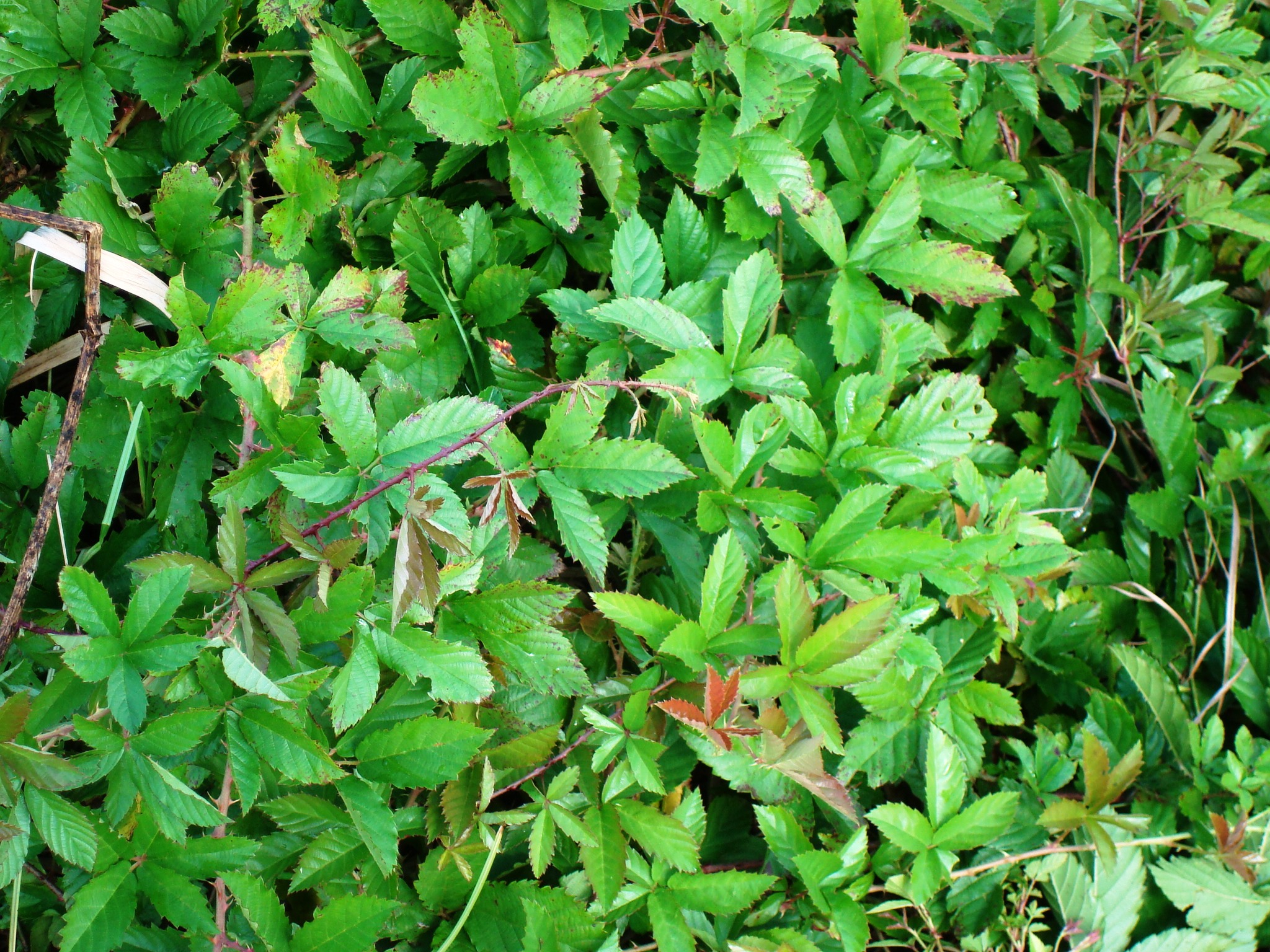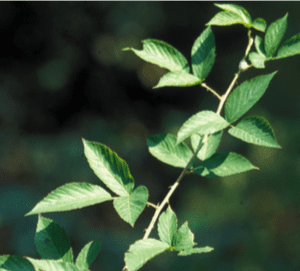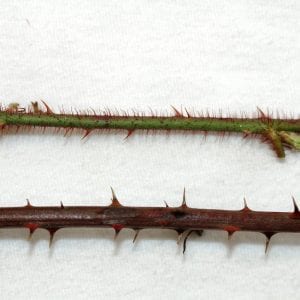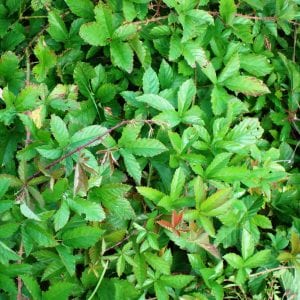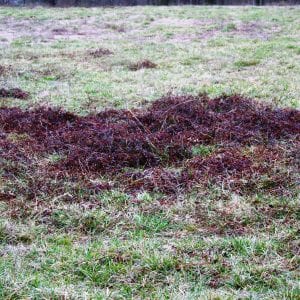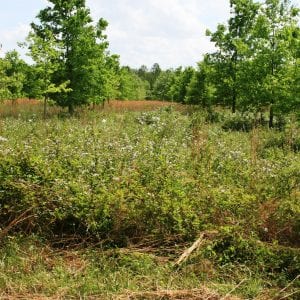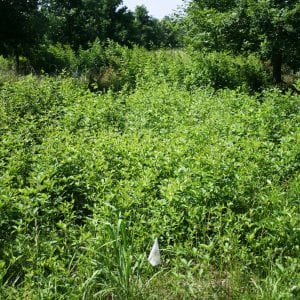Farming

These hard-to-control prickly shrubs can reduce grazing and hay quality as well as injure livestock. Find answers to managing their growth and spread in these frequently asked questions.
Blackberry and dewberry shrubs are a species of Rubus, a genus of often prickly shrubs. While closely related, the two are very different in growth habits and physical characteristics. While dewberry is much more difficult to control than blackberry, especially in hayfields, both types of briar patch present problems in pastures and hayfields across Alabama. For producers, the question is, What can I do about it?
Q: How can I quickly tell dewberry from blackberry?
From a distance, dewberry and blackberry can be easily confused, but they are relatively easy to distinguish upon close examination. Dewberry exhibits low, vine-like, trailing growth, which forms mats that are rarely taller than 2 feet above the ground. This is why dewberry is sometimes called trailing blackberry. Blackberry typically exhibits upright, rambling growth, which can form impenetrable thickets that are often 4 to 6 feet tall.
Stems of dewberry have slender thorns and numerous red hairs, while upright blackberry stems have few to no hairs and numerous hard, broad-based thorns. Although the flowers produced by both may look similar, dewberry tends to flower about 1 to 2 months earlier in the spring than does blackberry.
Q: Why are blackberry and dewberry so abundant in Alabama?
Several native species of blackberry and dewberry found in Alabama are well-adapted to grow in grasslands, forest edges, and open, disturbed areas. Rubus species produce attractive fruits that are consumed by many species of birds and wildlife, and the seeds are subsequently widely dispersed. Pastures create ideal conditions for Rubus species, as cattle generally avoid them if possible. Hayfields also create conditions that especially favor low-growing, vine-like plants, such as dewberry, that can tolerate repeated cutting.
- Highbush blackberry is a common species that is weedy in pastures throughout Alabama (Photo credit: James H. Miller, USDA Forest Service, Bugwood.org)
- Dewberry stems (top) have slender thorns and numerous red hairs while most species of blackberry (bottom) have hard, broad-based thorns and few to no hairs.
- Dewberry is a frequent problem in pastures and hayfields. The trailing growth habit quickly begins to smother forage species.
Q: What are the best herbicide options for blackberry and dewberry control?
Only a few herbicide active ingredients are effective for blackberry and dewberry control, and their use is based on the forage grasses being grown. The most effective herbicide active ingredient for dewberry control is metsulfuron. Blackberry is effectively controlled by triclopyr, metsulfuron, and fluroxypyr.
Metsulfuron is found in products such as Chaparral, Cimarron Plus, and some generic products that can
be safely used on established bermudagrass pastures and hayfields. Metsulfuron, however, will kill ‘Pensacola’ bahiagrass and injure or kill tall fescue at the rates needed for dewberry control. If you want to keep ‘Pensacola’ bahiagrass or tall fescue, do not use any product with metsulfuron for dewberry control.
Triclopyr is found in products such as Remedy Ultra, Pasturegard, and some generics and is safe to use on established cool- and warm-season forage grasses. Fluroxypyr is found in products such as Pasturegard and Surmount and also is safe on warm- and cool-season forage grasses.
Q: If I can use metsulfuron, what are my best options?
Apply Chaparral at 3 to 3.3 ounces per acre or apply Cimarron Plus at 0.62 to 1.2 ounces per acre. With either product, add a nonionic surfactant at 0.25 percent v/v (1 quart per 100 gallons spray mix).
While application can be made anytime from spring until fall, best results have been obtained with fall treatment. If it is not possible to wait until fall, you must allow the leaves to fully expand in the spring before treatment. In hayfields, wait until the stems are completely desiccated after treatment before hay cutting. This may mean you need to cut around treated patches for 1 to 2 months. You also can apply in the fall after the last cutting if you have good dewberry growth. To get sufficient growth, however, you may need to mow around dewberry patches over the summer to get enough regrowth by early fall.
Note: The herbicide Pastora contains metsulfuron and can be used in bermudagrass to control problem weeds such as bahiagrass and vaseygrass. However, when applied at the 1.5 ounces per acre rate with surfactant, Pastora will only suppress dewberry growth when there is adequate regrowth at the time of treatment. Therefore, when using Pastora, consider dewberry suppression an added benefit, but use other products when the primary focus is dewberry control.
Q: I have bahiagrass or tall fescue and do not want to use metsulfuron. What are my best options?
Apply Pasturegard HL at 1.5 to 2 pints per acre with a nonionic surfactant at 0.25 percent v/v or Remedy Ultra at 2 pints per acre or Surmount at 4 pints per acre with a nonionic surfactant at 0.25 percent v/v. Surmount is a “restricted use pesticide.”
Pasturegard, Surmount, and Remedy are safe on bermudagrass, bahiagrass, and tall fescue. Make applications when the leaves are fully expanded and the foliage is dark green. Wait until the stems are completely desiccated before cutting the treated area. This may mean you need to cut around treated patches for a month or two. You also can apply in the fall after the last cutting if you have good dewberry or blackberry regrowth. To get enough regrowth, you may need to mow around dewberry patches over the summer to be ready to treat by fall.
Note: Pasturegard, Remedy Ultra, and Surmount may be less effective if mowing has occurred within a year prior to treatment for either species. Remedy Ultra also has been shown to provide variable dewberry control.
- Dewberry patches often exhibit a dark reddish color in the winter, which makes them readily stand out in pastures and hayfields.
- Upright blackberries form dense thickets that reduce forage productivity and limit grazing. If uncontrolled, upright blackberries can completely take over a pasture.
- Blackberry regrowth approximately six weeks after mowing. While it is tempting to spray, you will have the best results by waiting until the following year.
Q: Can you clarify the issue with mowing or clipping and herbicide treatment?
Mowing or hay cutting alone will not control dewberry or blackberry. It may temporarily reduce the size or top growth of these weeds, but they will rapidly recover. Mowing can remove old, dead stems and leaves that may interfere with herbicide deposition and create conditions that may make herbicide application to new uniform regrowth easier.
When mowing first, keep in mind that best control results have been observed when the herbicide application is made in the following year, especially for Pasturegard, Remedy Ultra, and Surmount. For example, you can mow in the summer the first year and then spray the following summer when shoots have regrown. Metsulfuron seems to be less sensitive to this mowing issue, which is why it is a better choice in hayfields if it can be used.
Frequently cut hayfields are where it is most difficult to get good control, especially for dewberry. No matter what herbicide you use, the following practices will result in poorer than expected blackberry and dewberry control:
- Mowing or hay cutting immediately followed by spraying
- Mowing or hay cutting followed by spraying but before there is sufficient regrowth to receive spray
- Spraying followed by hay cutting before treated stems are crispy all the way to the ground
- Spraying blackberry or dewberry growing under drought-stress conditions
Q: What about dicamba + 2,4-D (Weedmaster) or 2,4-D alone?
Research has shown that these products do not provide consistent control of dewberry and blackberry. These products generally will control top growth, but plants recover very quickly from the roots.
Q: What about soil pH and fertility?
Take a soil test and follow recommendations for your forage grasses to keep them as healthy as possible. Blackberry and dewberry species can tolerate lower pH and lower fertility than can most forage grasses, and they likely will be more competitive when pH and fertility are low.
Q: What about cattle grazing before and after spraying?
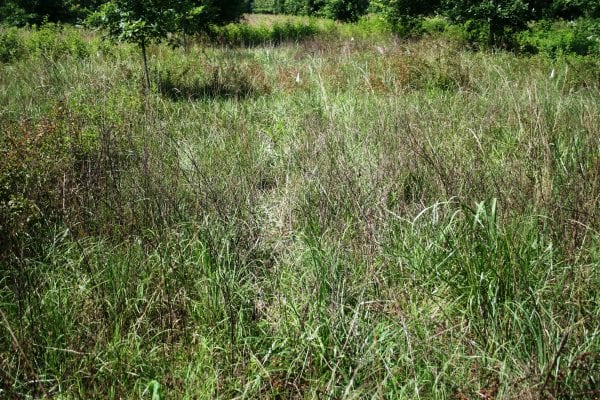
After treatment, blackberry stems should be completely desiccated (crispy) before mowing. This ensures that the herbicide has had time to do its job.
Cattle may lightly graze the tips of many Rubus species, but they generally avoid them due to the thorny growth. There are no grazing restrictions for beef cattle for any herbicide discussed in this publication. However, mob grazing that may result in trampling of blackberry or dewberry should be avoided until stems are completely desiccated.
Q: I have heard that goats can control blackberry. Will they control dewberry too?
Goats are very effective in controlling blackberry and many other woody plants, including kudzu, poison ivy, and mimosa. Goats have not been used frequently in Alabama for weed control, especially in hayfields. Systems approaches for dewberry weed control in hayfields with goats have yet to be developed.
Q: Are there any other important considerations?
Blackberry or dewberry control is expensive, so get the most out of each treatment. Make sure the sprayer is properly calibrated, and always read and follow directions on the herbicide label for any product you use.
With any herbicide approach, remember that the problem did not develop overnight and cannot be solved with one treatment. You likely will need to re-treat for several years to get on top of the problem. Similar to many other pasture weeds, both blackberry and dewberry species may form persistent seed banks in the soils, and the roots are difficult to completely kill with any management approach. However, with persistence, these weeds can be effectively managed.
Edited by Leanne Dillard Extension Specialist, Assistant Professor; Johnny Gladney Regional Extension Agent; Josh Elmore Regional Extension Agent; and Gerry Thompson Regional Extension Agent, all at Auburn University. Written by Stephen Enloe Former Extension Specialist, Auburn University
Reviewed August 2023, Control of Blackberry and Dewberry in Pastures and Hayfields, ANR-2145

